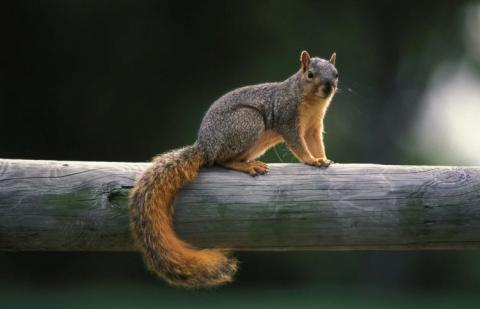About Squirrels
In Missouri, hunters may pursue two species of tree squirrels — fox squirrels, called "red squirrels" by many, and eastern gray squirrels.
Fox squirrels are the larger of the two species. They tend to be found near the edges of timber stands, in isolated woodlots and open woods without much understory, along timbered ridges and uplands, and even in hedgerows. Grays are more likely to occur in extensive tracts of forest and bottomlands, but it’s not unusual to find both species using the same area.
Gray squirrels are early risers and become active at sunrise, while fox squirrels tend to come out later in the morning and are active during mid-day. The activity of both species slows considerably in the mid-day hours on hot, humid summer days.
Squirrel Behavior
Gray and fox squirrels use both leaf nests and den cavities. Cavity nests are most often in the hollow trunk or large limb of a live tree, but squirrels will also use cavities in dead snags. Cavity nests are used more in the winter and during the spring reproductive period. These locations are warmer, more sheltered from weather and predators, and help keep the young protected. Leaf nests tend to receive more use in summer, perhaps because they’re cooler than den nests. Hunters should not shoot into leaf nests, and should avoid shooting squirrels peeking out of cavities where they are unlikely to be recovered.
Missouri’s squirrel season is long, running from late spring through late winter. Squirrel behavior and activity change throughout the year as they respond to differences in weather and food availability. Be observant and adapt your hunting according to what the squirrels are doing or eating.
Getting Started
Those new to squirrel hunting should remember to move slowly through the woods, scanning the treetops for movement, and listening for the sounds of bushy tails jumping from limb to limb or cutting and dropping nut hulls. Upon finding a lot of fresh cuttings on the ground, find a comfortable spot nearby and sit down awhile — you’ll usually have a shot or two shortly.
What You'll Need:
- A .22 caliber rifle or shotgun (preferably 410 or 20 gauge)
- No special clothing is required.
- Stealth — be alert and quiet as you move through the woods.
Tips and Tricks
Being still is an effective way to find elusive squirrels.
- Walk slowly through the woods, as quietly as possible.
- Stop every 30 to 40 yards for 5–10 minutes to search the tree tops for movement.
- When taking a shot, approach squirrels from an angle until you can get a good shot. Walking directly at them will make them more nervous and eager to flee.
Early-Season Hunting
Especially during years of good acorn and hickory nut production, squirrels can become preoccupied with the abundant food source, but the sound of snapping twigs or rustling leaves will quickly get their attention.
- Move slowly and deliberately through the woods to avoid putting squirrels on high alert.
- If discovered (and it will happen), find a well-hidden spot and take a break for 20–30 minutes. This is often enough time for the squirrels to resume their feeding activity.























